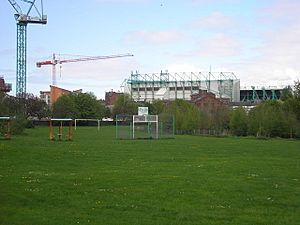Lochend, Edinburgh facts for kids
Lochend is a neighborhood in Edinburgh, the capital city of Scotland. It's mostly a place where people live. The name Lochend comes from Lochend Castle and Lochend Loch, a nearby lake. This area is about two miles from the center of Edinburgh. Many of the homes in Lochend were built in the 1930s as part of a public housing project. The street called Easter Road is on its western side.
Contents
What is Lochend?
Lochend is a busy part of Edinburgh. It's known for its homes and green spaces. The neighborhood offers a mix of history and modern life. It's a place where many families have lived for generations.
The Story of Lochend Loch
Lochend Loch is a small lake that gets its water from underground springs. It doesn't have a river flowing out of it. Long ago, this loch was important because it supplied water to the nearby town of Leith through pipes.
A Home for Wildlife
In the 1960s, parts of the loch were filled in. This was done to make the water shallower and safer. Today, the loch is fenced off and has many plants growing around it. It has become a special place for local wildlife. You can often see different birds and other animals living there. The loch is a main feature of Lochend Park.
Lochend Castle and House
Near the loch, you'll find the remains of Lochend Castle. Most of the castle was taken down in the 1500s. However, some parts of the old castle were used to build Lochend House in the 1800s. This house still stands today.
The Old Dovecote
In Lochend Park, there's also a very old building called a doocot. This doocot was built in the 1500s and was part of the castle's estate. A doocot is a special building where pigeons or doves were kept. People used to raise them for food or for their eggs. This beehive-shaped doocot is a cool piece of history.
Royal Visits to Lochend
Even kings visited Lochend long ago! James IV of Scotland came to Lochend in September 1507. He came to hunt wild birds. Records show that four men were paid to row a boat on the "loch of Restalrig" to help scare up the birds for the king's hunt. It shows that the area was once a popular spot for hunting.


